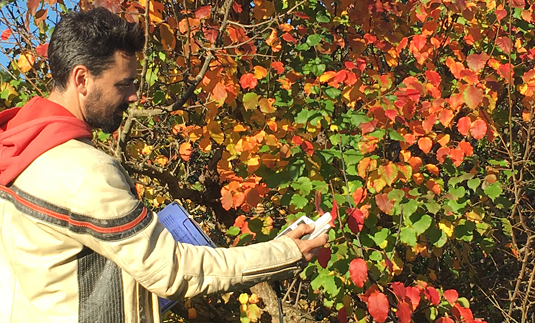Adjusting to fluctuating temperatures

The duration of the vegetation period – i.e. the time that elapses between leafing out (the emergence of the first leaf) in spring and the initiation of leaf loss in autumn – is a highly significant ecological parameter that has a considerable influence on both plant productivity and the biogeochemical cycling of vital nutrients in ecosystems. However, the mechanisms that determine the length of the vegetation period for any given species are poorly understood. Hence, in order to assess the potential impact of global climate change on plant productivity, for instance, more information on the timing of the growing seasons of a wide range of plant species is required. In a large-scale study, LMU botany professor Susanne Renner and her colleague Constantin Zohner have now measured this parameter for a large sample of woody plant species from the Northern hemisphere. Their findings, which have now been published in the journal Nature Ecology and Evolution, reveal significant differences between species that are native to North America on the one hand, and European and East Asian trees and shrubs on the other.
Susanne Renner is also Director of Munich's Botanic Garden, which has in cultivation some 19,000 species and subspecies of plants from all over the world. For their new study, Renner and Zohner selected 396 species of woody plants grown permanently outdoors and determined the lengths of their respective vegetation periods under ambient conditions. "In addition to carrying out phenological monitoring, we experimentally determined the timing of chlorophyll degradation in the leaves, which signals the beginning of the senescence process," Zohner explains.
Strikingly, the experimental data revealed that in North American species, the degradation of chlorophyll begins, on average, 9 days earlier than in the European speciees and 11 days earlier than in the Eastern Asian species. Conversely, when they ascertained the dates of leaf emergence, they found that leafing out in North American plants was markedly delayed relative to the European and Asian woody plants in their experimental sample. The overall effect of these disparities is that native North American species have a vegetation period that is approximately 3 weeks shorter than that of any other species, all grown under the same experimental conditions. Renner and Zohner postulate that this intrinsic difference reflects the fact that the interannual range of temperatures on the North American continent is greater than that encountered in either Europe or Asia. This factor should favor the adoption of a more conservative growth strategy, which would be expected to minimize the risk of exposure to cold at both ends of the growing season.
Of the 396 species selected for the study, 110 European and Asian species have established in North America, but have retained the longer growth periods characteristic of their ancestral habitats. It was thought that this trait might give such species an advantage over native trees and shrubs. Indeed, approximately half of these introduced species are classified as invasive, as they continue to extend their geographical range in their new home. So the Munich researchers investigated whether the innately longer growing seasons of introduced species might favor their dispersal in North America.
"We therefore asked whether or not invasive and non-invasive introduced species differ with respect to the duration of their vegetation periods," Renner says, "and found that they do not. So the length of the growing season alone is a poor indicator of the ability of a species to colonize new habitats. At all events, because of their intrinsically longer growth periods, these non-native species will have an impact on plant productivity and the CO2 balance of North American forests."
More information: Constantin M. Zohner et al. Innately shorter vegetation periods in North American species explain native–non-native phenological asymmetries, Nature Ecology & Evolution (2017). DOI: 10.1038/s41559-017-0307-3
Journal information: Nature Ecology & Evolution
Provided by Ludwig Maximilian University of Munich
















